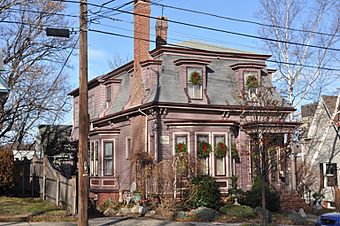Lydia Pinkham House facts for kids
|
Lydia Pinkham House
|
|

South profile and east elevation, 2012
|
|
| Location | Lynn, Massachusetts |
|---|---|
| Built | circa 1872 |
| Architectural style | Second Empire Cottage |
| NRHP reference No. | 12000818 |
Quick facts for kids Significant dates |
|
| Added to NRHP | September 25, 2012 |
| Designated NHL | August 25, 2014 |
The Lydia Pinkham House was the home of Lydia Pinkham in Lynn, Massachusetts. Lydia Pinkham was a famous businesswoman in the late 1800s. She was known for making and selling special health products.
It was in this house that she created "Lydia Pinkham's Vegetable Compound." This product was meant to help women with common health issues. The house's address, 285 Western Avenue, became very well known. Women from all over the country would write to Lydia Pinkham for advice. The company wanted people to believe that Lydia made her famous compound right in her home. Lydia herself would answer these letters. Even after she died in 1883, the company kept answering letters in her name for many years.
Contents
The History of the Pinkham House
This house was built around 1872. It was either built by Charles Beede or Leander Berry. Charles Beede sold the land in 1871, and Leander Berry bought it. The house was built in a style called "Second Empire." This style was very popular at the time. It included a special roof called a Mansard roof.
In 1876, Charles Beede bought the property back. He then rented it to Isaac and Lydia Pinkham. At that time, it was the only Second Empire style home in the area. The Pinkhams lived in this house until Lydia passed away. While they lived there, her company became famous across the country.
Making the Compound at Home
The basement of the house has large storage areas. There is also proof that a big stove was once in the basement. This stove was likely used to make the Pinkham compound. This shows how important the house was to the company's early success.
Changes to the House Over Time
The original house had an "ell." An ell is a part of a building that sticks out like the letter "L." Between 1922 and 1928, more rooms were added to the second floor. A sleeping porch was also added. Two fireplaces were built on the outside of the house. Around the year 2000, the building was fixed up in a big way.
A Special Historic Place
The Lydia Pinkham House was added to the National Register of Historic Places in 2012. This means it is an important historic building in the United States. Two years later, it was given an even higher honor. It was named a National Historic Landmark. This shows that it is a place of great national importance.



